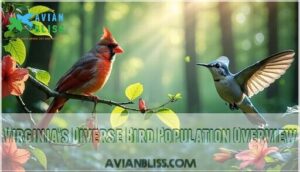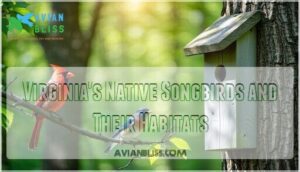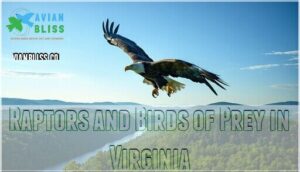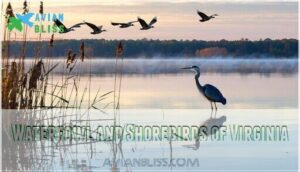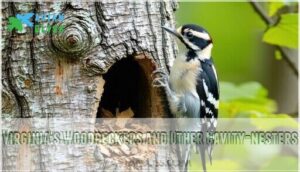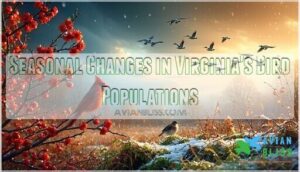This site is supported by our readers. We may earn a commission, at no cost to you, if you purchase through links.
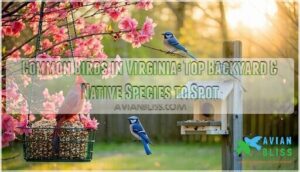
Keep an ear out for the bubbly tunes of the Carolina Wren or the mockingbird’s mimicry—it’s like nature’s own DJ.
At feeders, expect regular visits from House Finches, Mourning Doves, and the occasional bold Downy Woodpecker.
Virginia’s mix of forests, wetlands, and backyards creates the perfect stage for these avian performers.
Want to spot even more? Seasonal shifts bring migratory species that keep birdwatching exciting year-round, with nature’s own show always putting on a display.
Table Of Contents
- Key Takeaways
- Virginia’s Diverse Bird Population Overview
- Identifying Common Backyard Birds in Virginia
- Virginia’s Native Songbirds and Their Habitats
- Raptors and Birds of Prey in Virginia
- Waterfowl and Shorebirds of Virginia
- Virginia’s Woodpeckers and Other Cavity-nesters
- Seasonal Changes in Virginia’s Bird Populations
- Frequently Asked Questions (FAQs)
- Where is the best place to go birdwatching in Virginia?
- When is the best time to go birdwatching in Virginia?
- What should I bring when going birdwatching in Virginia?
- How can I attract birds to my backyard in Virginia?
- How can I identify bird species in Virginia?
- What are the most common birds in Virginia?
- How can I identify a bird in my yard?
- What is the big bird in Virginia?
- What Virginia bird has a red throat?
- How do you identify birds in Virginia?
- Conclusion
Key Takeaways
- You’ll find a mix of vibrant backyard birds like the Northern Cardinal, Blue Jay, and Carolina Wren, easily attracting them with sunflower seeds and birdbaths.
- Virginia’s habitats, from wetlands to forests, support 487 bird species, making birdwatching exciting year-round.
- Spring and fall migrations bring rare and colorful species along the Atlantic Flyway to Virginia’s key birding spots like Chincoteague.
- Learning to identify birds by their plumage, songs, and behaviors helps connect you to Virginia’s rich birdlife.
Virginia’s Diverse Bird Population Overview
Virginia is home to an impressive 475 bird species, making it a hotspot for avian diversity in the eastern United States.
The state’s varied habitats, from coastal areas to mountain forests, provide essential resources for both resident and migratory birds, supporting a wide range of species and making it an ideal location for avian diversity.
Number of Bird Species in Virginia
Virginia is home to an amazing 487 bird species, showcasing a vibrant mix of native birds, migratory travelers, and rare finds.
Whether you’re admiring common species like the Northern Cardinal or searching for Accidental Species, this region offers endless surprises.
The Virginia bird species list highlights:
- Introduced Birds like the House Sparrow, blending into collections of local birds.
- Exciting rarities that boost Checklist Frequency for birdwatchers.
- Sadly, one Extinct Species, a reminder of conservation efforts needed.
Many of these are Virginia birds of prey, such as eagles and falcons.
With such bird abundance, exploring Virginia’s skies and green spaces is a joy for seasoned enthusiasts and curious visitors alike.
Factors Contributing to Virginia’s Bird Diversity
Why do so many Virginia birds call this state home? It’s all about habitat variety, climate influence, and migration routes.
From mountain forests to coastal wetlands, bird habitats here cater to both native birds and travelers.
The Atlantic Flyway brings countless species, while conservation efforts protect delicate ecosystems.
Add food availability like seeds, nuts, and insects, and you’ve got a bird paradise.
| Habitat Type | Key Species | Seasonal Activity |
|---|---|---|
| Coastal wetlands | Herons, ducks, geese | Winter stopovers |
| Appalachian forests | Songbirds, woodpeckers | Year-round residents |
| Grasslands | Sparrows, larks | Summer breeding |
| Urban areas | Cardinals, chickadees | Year-round sightings |
| Riparian zones | Warblers, kingfishers | Spring migration |
Importance of Birds in Virginia’s Ecosystem
Birds play an essential role in keeping Virginia’s ecosystems thriving.
They’re nature’s multitaskers, contributing substantially to habitat health and the food web. Here’s how:
- Pest Control: Virginia birds like woodpeckers consume insects that could harm crops and forests, acting as natural exterminators.
- Seed Dispersal: By eating fruits and spreading seeds, birds assist in growing forests and maintaining ecosystem services.
- Pollination: Hummingbirds spread pollen between flowers, supporting plant reproduction and vibrant landscapes.
Bird conservation is vital. Protecting these avian lifeforms guarantees stable ecosystems, benefits wildlife, and preserves biodiversity for Virginia’s future. Never underestimate their quiet impact!
Identifying Common Backyard Birds in Virginia
You can spot many fascinating birds right in your Virginia backyard by focusing on their unique field marks, songs, and behaviors.
From the vibrant red Northern Cardinal to the cheerful American Goldfinch, these species are easy to identify with a bit of careful observation and by recognizing their unique characteristics.
Field Marks and Physical Characteristics
Recognizing Virginia birds gets easier with a sharp eye for plumage coloration, body size, and beak morphology. Focus on their colors and distinctive markings—Northern Cardinals flash crimson feathers and crested heads, while American Goldfinches shine bright yellow with black accents.
Watch for tail shape and wingspan variation too, as these traits are nature’s signatures. Carolina Chickadees wear black caps and white cheeks, and Blue Jays sport vibrant blues.
Use the guide below to compare features at a glance:
| Bird | Plumage | Wingspan |
|---|---|---|
| Northern Cardinal | Bright red | 10-12 inches |
| Carolina Chickadee | Black cap, white | 7.5-8 inches |
| Blue Jay | Blue, white belly | 13-14 inches |
Each bird tells its story in bold patterns—start watching!
Bird Songs and Calls
Every morning, Virginia’s birds perform a stunning dawn chorus, showcasing their unique calls and songs.
Want to sharpen your song identification skills? Here’s how:
- Northern Cardinal: Listen for the loud, chipper “cheer-cheer-cheer,” standing out with melodic clarity.
- Carolina Wren: Its distinct “teakettle-teakettle” often echoes in wooded areas.
- American Goldfinch: Recognize its cheerful, whistled “po-ta-to-chip” mid-flight.
With training, uncover hidden stories in bird songs and regional dialects!
Behavior and Habitat Preferences
Understanding bird behavior and habitat selection is like uncovering a secret world.
Virginia birds, such as the lively Carolina Wren, prefer dense shrubs where they energetically chatter.
Northern Cardinals, known for their bold nesting habits, often seek thick foliage, while Blue Jays confidently command high treetops.
Mourning Doves, with their waddling feeding strategies, forage seeds from the ground.
Each species thrives in specific habitats, forming routines that reflect unique migration patterns and social behaviors.
To encourage these common birds, design your yard with native plants offering food and cover.
A simple way to attract them is to offer black oil sunflower seeds, which provides a bird-friendly environment.
It’s the perfect way to turn your space into a retreat that supports their natural behaviors, making it an ideal spot for bird watching.
Common Feeder Visitors
Your backyard can be a magnet for Virginia birds like the cheerful Carolina Chickadee and the flashy Northern Cardinal.
To attract these common birds, consider their preferences:
- Seed Preferences: Offer sunflower seeds, suet, or nyjer for a feeding frenzy.
- Feeder Types: Use a mix of platform, tube, and ground feeders to accommodate all visitors.
- Bathing Habits: Add a birdbath for hydration and hygiene.
Clean bird feeders regularly to keep your backyard birds healthy.
Many enthusiasts purchase seeds for wild birds to keep feeders full.
During winter, these backyard birds appreciate high-energy snacks, while nesting materials help them prepare for spring.
Virginia’s Native Songbirds and Their Habitats
You’ll find Virginia’s native songbirds thriving in diverse habitats, from dense forests to open meadows and wetland edges.
Each species plays a pivotal role in its ecosystem, making these birds fascinating to observe and essential to protect.
Forest-dwelling Songbirds
Virginia’s forests are alive with the melodies of songbirds like the Carolina Chickadee and Tufted Titmouse. These species captivate with their nesting strategies and diet diversity, thriving in Appalachian habitats.
You’ll spot them flitting among oak canopies or foraging near moss-covered trunks. Song variations, from the Blackburnian warbler’s high-pitched trill to Swainson’s warbler’s shy melody, paint an auditory masterpiece.
Forest conservation helps preserve these habitats, supporting Virginia birds that rely on diverse ecosystems for nesting and survival. Many residents enhance these habitats with Virginia bird houses.
| Bird Species | Habitat Preference | Unique Feature |
|---|---|---|
| Black-throated Green | Mixed hardwood forests | Vibrant green plumage |
| Swainson’s Warbler | Dense underbrush | Shy, elusive behavior |
| Carolina Chickadee | Oak-dominated woodlands | Cheerful "fee-bee" call |
Meadow and Grassland Species
Rolling meadows and grassland habitats in Virginia are perfect for spotting unique bird species with fascinating behaviors.
These open spaces teem with life, where birds find nesting grounds and forage for food.
Keep an eye out for these common birds:
- Eastern Meadowlark: With a vibrant yellow breast and a bold black “V,” it’s easy to spot. Its melodious flute-like song fills the air as it perches on fence posts.
- Grasshopper Sparrow: Small yet stocky, this bird mimics a grasshopper’s buzz, blending into grassy surroundings.
- Bobolink: This quirky songbird shines with its whimsical, toy-like calls, enriching meadows with charm and character.
Consider exploring identification product options for the Eastern Meadowlark. Protecting these spaces guarantees Virginia birds thrive.
Wetland and Riparian Songbirds
Wetlands and riparian habitats in Virginia host diverse songbirds, like Swainson’s and Prothonotary Warblers.
These birds rely on wetlands for their diets of insects and aquatic plants while nesting in tree cavities or shrubs.
Their migration patterns often lead them to these areas, making wetlands essential stopovers.
Conservation efforts guarantee these habitats remain pristine.
| Species | Habitat Usage | Diet |
|---|---|---|
| Swainson’s Warbler | Shrubs, Bottomland | Insects, Small Seeds |
| Prothonotary Warbler | Tree Cavities | Aquatic Insects |
| Shorebirds | Mudflats, Wetlands | Worms, Invertebrates |
Urban and Suburban Adaptable Species
Urban areas aren’t just for people—Virginia birds thrive here too.
You’ll often spot the Northern Cardinal or American Robin in suburban areas, busy with nesting habits. Blue Jays bring drama to backyard bird feeders, while Mourning Doves perch peacefully on rooftops. Even common birds like House Sparrows embrace human interaction, using leftovers to flourish.
- Feeder Preferences: Attract cardinals with sunflower seeds.
- Nesting Habits: Robins build nests in shrubs or eaves.
- Population Growth: Urban wildlife keeps expanding.
- Conservation Efforts: Native plantings invite Virginia birds.
- Suburban Birds: Keep watch for doves in open yards.
Raptors and Birds of Prey in Virginia
You’ll find Virginia’s raptors soaring through open skies or perched high in trees, scanning for prey with sharp talons and keen eyesight.
From majestic eagles to stealthy owls, these birds of prey play a critical role in maintaining the balance of local ecosystems.
Hawks and Falcons
Hawks and falcons, the ultimate sky hunters, thrive in Virginia with unmatched agility and sharp instincts.
These raptors, like the red-tailed hawk and Peregrine falcon, are fascinating to observe.
Their behaviors tell compelling stories:
- Raptor migration dazzles with massive hawk kettles cruising through mountain passes.
- Hawk habitats vary—red-tailed hawks prefer forests, while falcons adapt to cities or open fields.
- Hunting techniques include stooping dives, used by falcons, and ambushes favored by sharp-shinned hawks.
- Conservation status highlights the importance of protecting these birds of prey.
Spot their majesty across Virginia’s skies!
Owls of Virginia
The owls of Virginia showcase fascinating adaptations as nocturnal hunters.
The petite Eastern Screech Owl enchants with soft trills, while the towering Great Horned Owl commands attention with deep, haunting hoots.
These raptors of Virginia thrive in diverse owl habitats, from dense forests to wetlands.
With silent wings, sharp talons, and keen eyesight, they dominate night skies.
Protecting these owls of Virginia guarantees the survival of unique creatures that embody the wonder of Virginia wildlife.
Eagles and Osprey
Bald eagles and ospreys, two remarkable raptors of Virginia, grace the skies near rivers and lakes.
Eagles, with stunning white plumage on their heads and tails, showcase powerful hunting skills.
Ospreys, known for sleek bodies and bold nesting habits, prefer lofty trees or man-made platforms.
Watching these aerial acrobats is unforgettable.
Here’s why they captivate:
- Diet Variations: Both rely on fish, though eagles may steal an osprey’s catch.
- Plumage Differences: Eagles’ white accents vs. ospreys’ mottled black and white.
- Conservation Efforts: Their resurgence highlights Virginia wildlife protection success.
Vultures and Scavengers
While often misunderstood, Virginia’s vultures serve as nature’s essential clean-up crew within the local ecosystem.
You’ll commonly spot both Black Vultures and Turkey Vultures soaring on thermal currents throughout the state.
These remarkable scavengers are protected under the Migratory Bird Act due to their pivotal ecological contributions:
- Disease Control Specialists: Their consumption of carrion prevents the spread of harmful pathogens in wildlife populations
- Efficient Recyclers: Strong stomach acids break down even tough carrion materials
- Adaptive Neighbors: From Leesburg’s suburban backyards to wooded areas, these birds demonstrate remarkable habitat flexibility
Next time you spot vultures circling overhead, appreciate their essential role in Virginia’s avian community.
Waterfowl and Shorebirds of Virginia
You’ll discover Virginia’s diverse waterfowl and shorebirds along the state’s coastal areas, inland lakes, and wetland habitats where numerous species gather during migration seasons.
From graceful herons stalking the shallows to ducks paddling across open water, these aquatic birds offer you fascinating glimpses into specialized adaptations that make them perfectly suited for life between land and water.
Ducks and Geese
After tracking Virginia’s aerial hunters, you’ll want to explore the state’s abundant waterfowl.
Virginia’s wetlands and Coastal Plains host remarkable duck and goose populations year-round.
With liberal 60-day seasons and 6-bird bag limits, waterfowl hunting has seen high harvests over the past decade.
You’ll spot members of the Anatidae family, including distinctive long-tailed ducks and surf scoters along coastal waterways.
Hooded mergansers frequent Virginia’s shores, while resident and migratory Canada geese form their iconic V-formations during seasonal movements.
For successful Duck Identification, watch for differences in plumage, bill shape, and feeding behavior.
Virginia’s Waterfowl Conservation efforts have helped maintain these species that contribute substantially to the state’s rich biodiversity.
Wading Birds and Herons
While strolling through Virginia’s wetlands, you’ll encounter elegant wading birds and herons that transform shallow waters into nature’s theater.
The Great Blue Heron, Virginia’s largest heron species, lives year-round in the state, displaying its majestic bluish-gray plumage and S-shaped neck in various freshwater and marine habitats. Thousands breed in the Chesapeake Bay region, earning Richmond the nickname "city of herons."
Bird watching enthusiasts can spot these common birds:
- Great Blue Herons stand tall in marshes, striking prey with their long, pointed bills while their conservation status remains stable
- Green Herons inhabit both salt and freshwater shorelines, showcasing unique hunting techniques in their preferred heron habitats
- Great Egrets demonstrate patient wading diets, using stillness as their primary hunting strategy
These carnivorous birds depend on wetland conservation for their survival and nesting behaviors.
Coastal and Beach-dwelling Species
Along Virginia’s coastlines, you’ll discover a vibrant community of beach-dwelling species.
American avocets, sandpipers, and oystercatchers probe the intertidal zones, while royal and common terns gracefully fish offshore. Ring-billed gulls with yellow legs contrast with pink-legged American herring gulls.
- Witnessing a black skimmer’s precision feeding – their unique lower mandible slicing through water
- Spotting a piping plover’s camouflaged nest – these vulnerable shorebirds need protected nesting beaches
- Watching laughing gulls’ communal gatherings – their cackling calls fill coastal habitats
Bird identification becomes easier with practice on Virginia’s diverse shorelines.
Migratory Patterns and Stopovers
Thousands of migratory birds transform Virginia’s landscape as they travel the Atlantic Flyway, nature’s own superhighway stretching along the East Coast.
You’ll witness this spectacular journey during spring and fall migrations when birds use Virginia as a vital refueling station. Chincoteague National Wildlife Refuge serves as a premier coastal stopover, where shorebird concentrations reach remarkable levels.
Various migration triggers prompt these seasonal movements, with climate impacts increasingly affecting traditional patterns. Stopover ecology is fascinating—birds need safe places to rest and refuel before continuing their journeys.
- Prime Birdwatching Locations: Eastern Shore refuges, coastal wetlands, Chincoteague National Wildlife Refuge
- Best Viewing Times: Peak fall migration (August-October), spring migration (March-May)
- Common Migrants: Warblers, raptors, sandpipers, waterfowl
- Migration Challenges: Weather patterns, habitat loss, food availability
Don’t miss the tiny songbirds that make non-stop flights of 1,500 miles on their way to South America!
Virginia’s Woodpeckers and Other Cavity-nesters
You’ll find Virginia’s woodpeckers and cavity-nesting species creating homes in dead trees and wooden structures throughout the state’s diverse habitats.
These specialized birds, including species like chickadees and nuthatches, use their unique adaptations to excavate nesting chambers that later benefit many other wildlife species when abandoned.
Common Woodpecker Species
Virginia hosts seven distinct woodpecker species, each with unique identification features.
You’ll commonly spot the Red-bellied Woodpecker constructing nests in tree holes across the state. When observing the Downy Woodpecker, note that Hairy Woodpeckers look similar but are larger – a key distinction for proper identification.
Diet specialization varies among species: most woodpeckers select unhealthy or recently dead trees for feeding and nesting. The Red-headed Woodpecker‘s vibrant crimson head makes it unmistakable.
The endangered Red-cockaded Woodpecker depends exclusively on old-growth pine forests, showcasing how habitat variation affects their conservation status. These birds consume insects, nuts, fruits, showcasing their diverse diet and highlighting the importance of old-growth pine forests.
Nuthatches and Chickadees
Many backyard bird watchers find themselves captivated by the charm and energy of nuthatches and chickadees in Virginia.
The White-breasted Nuthatch displays distinctive behavior, walking headfirst down tree trunks with bold moves while searching for insects in bark crevices. You’ll recognize their sleek black, white, and gray feathers easily during bird identification sessions.
Carolina Chickadees nest in tree cavities 8-15 feet above ground, creating a cozy home for their clutch of five to nine eggs. Their characteristic "chick-a-dee-dee-dee" vocalizations help with bird watching success.
Both species thrive in deciduous forests and join winter foraging flocks. To attract these cavity-nesting backyard birds, install nest boxes and keep feeders stocked—they’ll visit often!
To further support chickadees, consider planting native berry bushes to supplement their diet.
Cavity-nesting Behavior and Adaptations
Cavity-nesting birds showcase remarkable home-building instincts throughout Virginia’s wooded landscapes.
When observing these feathered architects, you’ll notice:
- Primary excavators like woodpeckers create fresh cavities annually in trees
- Secondary nesters such as chickadees reuse abandoned cavities
- Excavation techniques vary by species, with specialized bill adaptations
- Nesting site selection prioritizes safety from predators
- Territorial behavior increases during breeding season
These adaptations demonstrate nature’s engineering prowess, turning simple tree hollows into perfect nurseries.
Importance of Dead Trees for Cavity-nesters
Dead trees, known as snags, play a pivotal role in forest ecology by providing essential habitat for cavity-nesting birds.
When you explore Virginia’s woodlands, you’ll notice woodpeckers select unhealthy or recently dead trees where the wood is softening—perfect for cavity excavation. These natural architects create homes not just for themselves but for the entire forest community.
Research shows woodpeckers primarily choose aspen trees for nesting sites, with an impressive 96% of cavities found in these trees. The decaying wood offers ideal conditions for creating nesting chambers while also hosting insect populations that provide food sources.
By maintaining snag habitat in your backyard or supporting forest management practices that preserve dead trees, you’re contributing to nesting ecology and biodiversity support. This simple action helps Virginia’s native birds like red-bellied and hairy woodpeckers continue their important ecological roles.
Seasonal Changes in Virginia’s Bird Populations
You’ll notice Virginia’s avian community transforms dramatically throughout the year, with migratory species arriving and departing based on seasonal cycles.
Throughout these seasonal shifts, you can observe both year-round residents like Northern Cardinals and seasonal visitors that follow established migration patterns across the commonwealth.
Spring and Fall Migration Patterns
While woodpeckers carve their homes in Virginia’s trees, twice each year the skies come alive with the spectacular movement of migratory birds.
Virginia sits along major Flyway Routes where bird migration creates breathtaking seasonal displays.
Different Migration Triggers prompt these journeys:
- Lengthening spring days signal northern-bound travelers to start their journey to breeding grounds
- Falling temperatures in autumn cue birds to head south toward warmer climates
- Declining food sources push birds to seek more abundant resources elsewhere
You’ll spot colorful warblers, majestic hawks, and tiny hummingbirds using critical Stopover Habitats across the state.
Conservation Efforts protect these habitats from Climate Impacts, ensuring common birds continue their ancient journeys.
Winter Residents and Visitors
As autumn leaves fall, Virginia’s Winter Bird ID scene takes center stage.
Rivers and lakes across the state host remarkable winter visitors, while some local species now stick around due to changing conditions.
You’ll spot these Cold Weather Adaptations experts at your feeders:
- Dark-Eyed Junco: True "snowbirds" with flashy white tail feathers
- Northern Cardinal: State birds that brighten Virginia’s gray winter days
- American Tree Sparrow: Rusty-capped visitors foraging beneath feeders
- White-throated Sparrow: Distinctive yellow eyebrow and melodious call
- Ruby-Crowned Kinglet: Tiny birds with occasionally visible red crown
Feeding Winter Birds is simple—fill your feeders with seeds and they’ll find Winter Roosting Spots nearby!
Many also appreciate black oil sunflower seeds.
Summer Breeding Species
When summer arrives in Virginia, thousands of breeding birds transform the landscape into a bustling nursery.
From April through August, Virginia’s barrier island beaches become critical nesting habitats for numerous bird species raising their young. You’ll notice birdsongs reaching its peak in early summer before gradually decreasing as June ends.
Many common backyard birds display fascinating breeding behaviors during this season. Songbirds carefully construct nests in various locations, with clutch sizes varying by species. Parent birds demonstrate remarkable parental care, constantly feeding hungry mouths and protecting their vulnerable offspring.
Some bird species make remarkable journeys to Virginia specifically for breeding purposes, with neotropical migrants typically attempting only one nesting effort per season. Fledgling success depends on factors like habitat quality and predator abundance.
For ideal bird identification opportunities, visit Virginia’s diverse ecosystems during late spring through early summer when breeding activity is highest. This period offers excellent chances to observe distinctive courtship displays and witness the next generation of Virginia’s bird species taking flight.
Year-round Resident Birds
While other birds migrate south, Virginia’s year-round resident birds tough out changing seasons in their familiar habitats.
These backyard birds display remarkable winter adaptations to survive the coldest months.
- Northern Cardinals and Carolina Chickadees maintain their territories throughout the year, adjusting their feeding habits to available food sources.
- American Robins and Eastern Bluebirds, once migratory, now increasingly stay put due to climate change and abundant backyard bird feeders, which is a notable year-round phenomenon.
Frequently Asked Questions (FAQs)
Where is the best place to go birdwatching in Virginia?
With 475 bird species recorded in Virginia, head to the Shenandoah Valley or Virginia Beach.
These hotspots, rich in diverse habitats, attract year-round residents and migrating birds, offering incredible opportunities for spotting rare and common species, especially in areas with rare species.
When is the best time to go birdwatching in Virginia?
Late spring through early summer offers the best birdwatching in Virginia.
You’ll spot nesting activity and vibrant plumage, especially in forested areas.
Mornings are ideal for catching birds at their busiest, foraging and singing.
What should I bring when going birdwatching in Virginia?
Pack binoculars, a field guide, and a notebook to document sightings.
Wear comfy shoes and neutral colors to blend in.
Don’t forget water, snacks, and bug spray—nature waits for no one, including mosquitoes!
How can I attract birds to my backyard in Virginia?
Set up feeders with sunflower seeds, suet, and peanut hearts.
Add water sources like birdbaths.
Plant native shrubs and flowers for shelter and food.
Avoid pesticides to keep insects available for natural foraging.
How can I identify bird species in Virginia?
Grab binoculars and a field guide to study shapes, colors, and behaviors.
Pay attention to size, wing patterns, and songs.
Apps like Merlin Bird ID can simplify identification when spotting birds in forests or backyards.
What are the most common birds in Virginia?
Virginia’s vibrant variety features fabulous favorites like the Northern Cardinal, Eastern Bluebird, and Mourning Dove.
Keep an eye out for sparrows, finches, and woodpeckers, who flock to feeders, forests, and familiar backyards year-round, especially to see the Mourning Dove.
How can I identify a bird in my yard?
Watch its size, shape, and colors; note patterns like stripes or spots.
Pay attention to its call, behavior, and diet.
Use a bird guide or app to match these traits for easier identification.
What is the big bird in Virginia?
Did you know Virginia hosts birds up to 24 inches long?
The Great Blue Heron is a standout with its majestic wingspan, sapphire-gray plumage, and striking presence in wetlands, rivers, and ponds across the state, and it is a key example of the majestic creatures found there.
What Virginia bird has a red throat?
The Ruby-throated Hummingbird stands out with its vibrant red throat, especially in males.
You’ll often spot these tiny, energetic birds flitting around gardens and feeders, feeding on nectar, insects, and small spiders during warmer months.
How do you identify birds in Virginia?
Picture a living puzzle—each bird is a unique piece.
Look for size, color patterns, beak shape, and behavior.
Notice habitats like forests or feeders, and listen for calls that reveal their identities.
Conclusion
It’s no coincidence that Virginia’s unique mix of habitats supports such diverse birdlife.
From common backyard birds like the vibrant Northern Cardinal to native songbirds of lush forests and wetlands, there’s always something exciting to observe.
By learning to identify these species by their field marks, calls, and behaviors, you’ll deepen your connection to nature.
Set up feeders, explore local trails, and enjoy the changing seasons—Virginia’s common birds promise endless opportunities to appreciate the outdoors.

